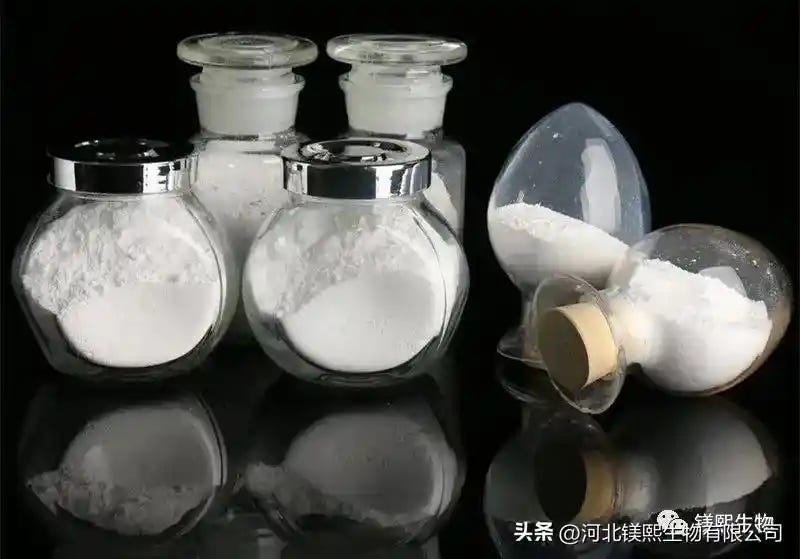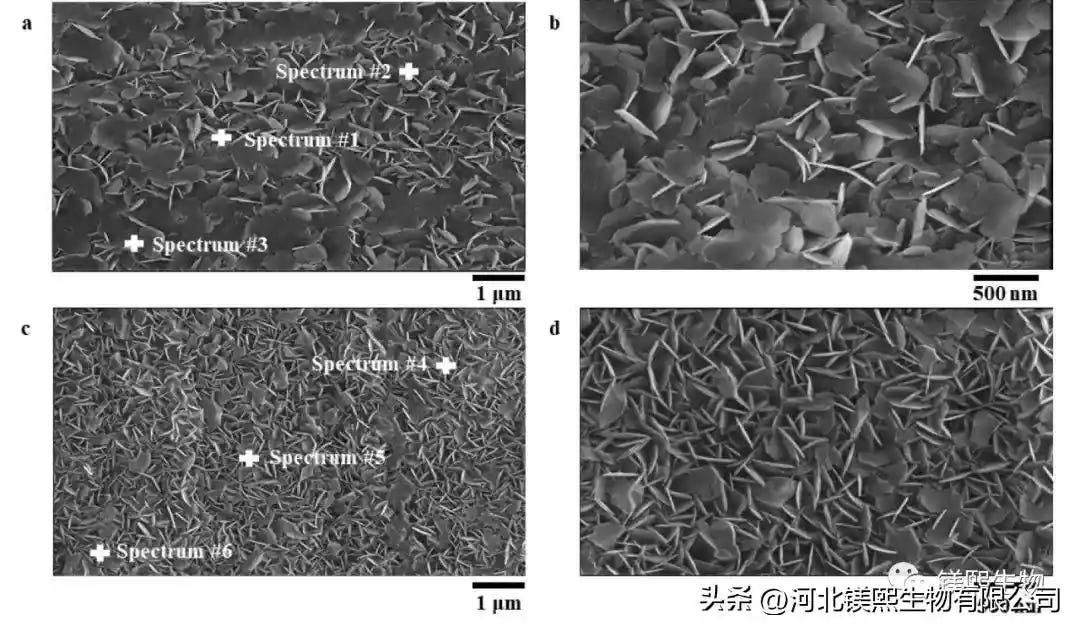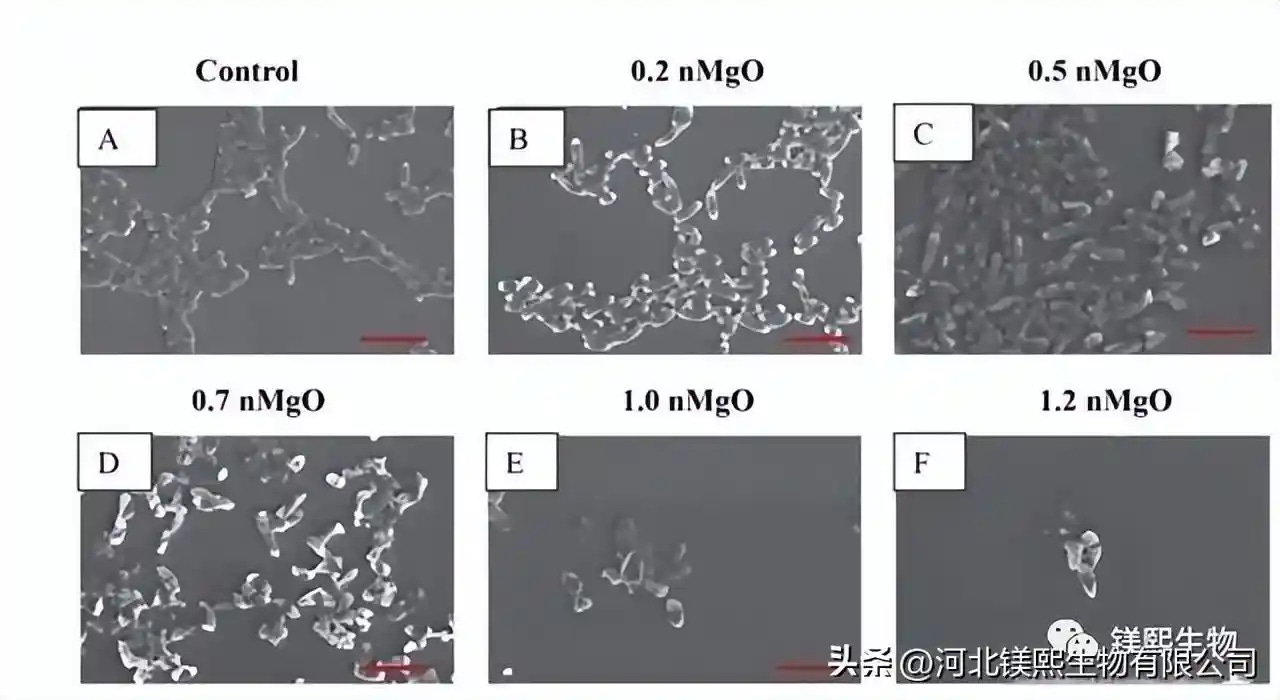Hebei Messi Biology Co., Ltd. stated that there are various methods for preparing nano-magnesium oxide. Magnesium nitrate hexahydrate is used as a precursor, and nano-magnesia powder is synthesized by citric acid sol-gel method, which is characterized and compared with that obtained by precipitation method. Comparing the preparation of magnesium oxide powder, it can be seen that the sol-gel method has the advantages of high purity, good uniformity, low temperature, and easy control of the reaction, and can be made into various types of bulk fiber film powder according to needs. different forms.
Nano-magnesium oxide material is a new type of high-function fine inorganic material. It is mainly used as accelerator and activator of chloroprene rubber, butyl rubber, nitrile rubber and fluorine rubber, as a filler in adhesives, plastics, paints and papers, and can also be used in the manufacture of ceramics, enamel, refractory materials and magnesium oxide cement, etc. , used medicinally as an antacid and laxative. The active nano-magnesia material has strong adsorption and high surface chemical activity. It can be used as a high-efficiency dissociation adsorbent to adsorb toxic chemicals, such as chlorinated hydrocarbons, organic phosphides and acid gases, for environmental protection. Nano-magnesium oxide film has good high temperature resistance effect, can be coated on the inner wall of high temperature furnace, and can also be applied in aerospace field; it also has good wear resistance, and has certain functions of moisture resistance and corrosion resistance.
1 Experimental purpose and experimental preparation 1.1 Experimental purpose (1) Raw material preparation and sample preparation of nano-magnesium oxide.
⑵Phase test of nano-magnesia samples by scanning electron microscope, X-ray diffraction analysis ⑶Process XRD data and analyze scanning electron microscope pictures, and summarize relevant conclusions.
1.2 Experimental preparation 1.2.1 Experimental drugs 1.2.3 Determination of experimental parameters The nitrate and carboxylate systems were used, with magnesium nitrate hexahydrate as the precursor. The action mechanism of citric acid, the effect of different process conditions (water, absolute ethanol, citric acid addition) on the stability of sol-gel and the effect of roasting temperature on the particle size and crystallinity of powder were studied.
Based on water: magnesium nitrate hexahydrate: citric acid: ethanol = 100:9:9:2.1 (molar ratio)
With 25ml of water as the standard, it is calculated based on relevant data:
2 Experimental process of nano-magnesium oxide 2.1 Experimental process 2.1.2 Experimental specific process (1) Mix 25ml of water, 32g of magnesium nitrate hexahydrate, 26.25g of citric acid, and 1.725ml of ethanol to make them uniform. Put the solution at 50°C
Stir at temperature for 30 minutes.
(2) Set the temperature to 80°C and stir for several hours and 2 hours.
(3) Stand still for at least 5 hours and the solution changes from a sol to a gel with a higher viscosity and a slightly yellowish tint.
⑷Put the gel that has been static for a long time into the baking furnace and bake at 500 ° C for 3 hours. The gel turns into a loose white honeycomb shape and shatters into a white powder when touched.
⑸ Electron microscope scanning to analyze its phase state, XRD to analyze particle size and related scientific parameters.
2.2 Problems in the experiment In the previous experiment, the magnesia obtained by roasting contained some impurities, and this problem could not be solved by prolonging the roasting time. The experiment found that the temperature of the roaster was limited and the temperature control device was unstable due to limited experimental conditions. In the whole test, the colloid formation environment is limited and can only be controlled artificially.
2.3 The reaction that occurred in the experiment Since the complexing ability of Mg2+ and citric acid is relatively strong, magnesium citrate will be generated first. The precursor of magnesium citrate is relatively complex, and there are polymers. At the same time, the following reaction of Mg2+ hydrolysis will occur: Mg2++2OH-Mg(OH)2
3 Preparation method and experimental data of nano-magnesia 3.1 Preparation of nano-magnesium oxide Using magnesium nitrate hexahydrate as the precursor, nano-magnesia powders with different particle sizes (10-100nm) and crystallinity were synthesized by citric acid sol-gel method . The action mechanism of citric acid, the effect of different process conditions (water, absolute ethanol, citric acid addition) on the stability of sol-gel and the effect of roasting temperature on the particle size and crystallinity of powder were studied. The results showed that when citric acid was not introduced, the stability of the gel was poor. The particle size of the magnesium oxide product was larger and the agglomeration was serious. After introducing citric acid, a stable gel system can be formed when water: magnesium nitrate hexahydrate: citric acid: ethanol = 100:9:9:2.1 (molar ratio). When the formed gel is heated, a redox reaction occurs, in which NO-3 provides an oxidizing atmosphere, COO-3 acts as a fuel, and NO-3 and COO-3 in the gel structure undergo "in-situ" oxidation at a certain temperature— - reduction reaction, so that self-propagating combustion occurs. Until all the xerogels are burned to form a loose powder.
3.2 Characterization of Nano Magnesium Oxide and Its Precursor The XRD spectrum of the powder sample made, compared with the standard spectrum of magnesium oxide, shows that the peak position is the same as the peak position of the standard spectrum (2θ=43.00°, 62.40°, 78.70°, 37.00 °, 74.80°) are completely consistent, indicating that the samples prepared in the experiment are MgO crystals, and no other impurity crystals are formed. The average particle diameter of the powder calculated by the Scherrer formula is 41nm.
4 Experimental results and analysis 4.1 Experimental results The nano-powder produced by the sol-gel method has narrow particle size distribution, good dispersion, high purity, easy control of reaction, less side reactions, simple process operation, and low roasting temperature, which can greatly reduce the cost of raw materials .
The particle size obtained by the sol-gel method tends to be consistent. The sol-gel method can control the microstructure of the material in the early stage of material preparation. The sol-gel method has broad application prospects in nano-oxides.
4.2 Results Analysis 4.2.1 Foaming Phenomenon When the precursor mixture is stirred and reacted at 80°C, a large number of bubbles will be generated, and a foamy anhydrous gel will be formed as the standing time prolongs. The foaming phenomenon is more obvious when fired at a temperature of 500 °C.
Based on a large number of experiments, we found that the foaming temperature is related to the viscosity of the precursor mixture sol. Generally speaking, foaming can occur when the concentrations of nitrate and citric acid are relatively small. Through multiple experiments, it is known that foaming is directly related to the concentration of citric acid, and has little to do with the concentration of nitrate, while the age of the colloid is mainly determined by citric acid. The greater the concentration of citric acid, the greater the viscosity, the foaming The higher the temperature.
Foaming is a basic feature of the sol, the phenomenon is the expansion of the volume of the sol, and the foamy anhydrous dry glue with holes is obtained, and the colloid will foam during the heating process.
4.2.2 How to prevent agglomeration (1) As a typical complexing agent, citric acid forms a complex with metal ions and then goes through the sol-gel process, but the metal ions are evenly distributed in the gel.
(2) Citric acid is a hydroxycarboxylate with a low molecular weight. Some carboxyl groups can replace the abundant hydroxyl groups on the surface of the oxide, and combine with metal ions to form a single-molecule adsorption layer, which makes the particle surface negatively charged and repels each other, and plays a role in dispersion. effect.
(3) The foaming process can effectively control powder agglomeration by preventing the formation of chemical bonds, preventing network collapse and reducing the self-propagating temperature.
5 Conclusions (1) The sol-gel method can obtain nano-sized MgO powders with uniform grain size, good dispersion and high crystallinity, and at the same time lay a foundation for the development of nano-MgO film materials in the future.
(2) The intervention of citric acid makes the reaction system more stable and plays a good role in dispersion.
(3) Precipitation method to prepare nano-magnesia, the raw material is cheap, the process is simple, and the requirements for equipment are not high; and the energy consumption is small, it is suitable for industrial production, and the prepared nano-magnesia is evenly dispersed.








0 Comments